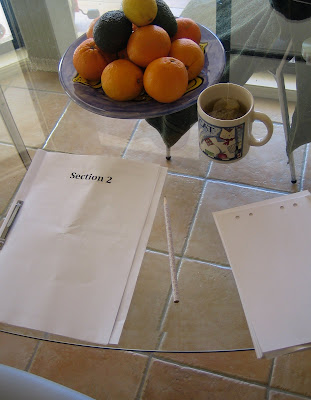
Wednesday, June 30, 2010
Instructions for Crochet Wrap Vest

Crochet Wrap Vest

 Introducing Moss, she is going to keep me warm all day today. What a perfect day for her too, with the extra low temps.
Introducing Moss, she is going to keep me warm all day today. What a perfect day for her too, with the extra low temps. Tuesday, June 29, 2010
Wrap Vest



What's On Your Table - Tuesday.
 There is not alot on my table this Tuesday. Actually other than this little treat I spoilt myself with just now, there is nothing on my table at all this Tuesday. I haven't been home until now, and just sat down to eat this, when I realised 'It's table Tuesday - what's on yours!'
There is not alot on my table this Tuesday. Actually other than this little treat I spoilt myself with just now, there is nothing on my table at all this Tuesday. I haven't been home until now, and just sat down to eat this, when I realised 'It's table Tuesday - what's on yours!' Monday, June 28, 2010
Itty Bitty Pancakes
 I am unable to share the recipe for these pancakes, sorry about that, however, if you google it, you will find many varieties to suit your preferences. I don't even know where I got my recipe from, we have had it so long.
I am unable to share the recipe for these pancakes, sorry about that, however, if you google it, you will find many varieties to suit your preferences. I don't even know where I got my recipe from, we have had it so long.Back For More - Pasta
 500g fettuccine pasta
500g fettuccine pastaThursday, June 24, 2010
Australia Has A New Prime Minister - It's A Girl!


My Creative Space



 Thanks for checking out my creative space this Thursday, and I would love to know what you are making or in the middle of this week.
Thanks for checking out my creative space this Thursday, and I would love to know what you are making or in the middle of this week. Wednesday, June 23, 2010
Look What I Found Today.

1. Avoid unnecessary consumption. Ask, 'Do I need it?'
Where possible, avoid unnecessary consumption. About 80% of all saleable products end up as waste, on average, within just 6 months. How we buy will influence directly what we buy so it is important to think about the way we spend money. Is the purchase based on need, importance, urgency, or impulse? Do I really need this? How much is enough? Can it be borrowed? Or sourced from a retailer with environmental credentials?
Make a preferred shopping list and keep to it. By planning ahead and anticipating the goods and services we will need - rather than making impulse buys - we give ourselves more time to find the most socially and environmentally responsible alternatives.
2. Remember, every purchase makes an impact, your choice makes a difference!
You make a difference. To shop with a conscience is to start to see the connections we have with the environment around us. Whatever the product, it will have or has had, some impact on the environment somewhere. However with each conscious choice we can minimise this impact.
Often you can feel that your small purchase doesn't really matter, you are 1 person amongst a world of 6 billion. In fact, it is because each small purchase does have an impact and there are 6 billion people that it adds up to one big difference. It is actually because each of our purchases do count, that we are in the environmental crisis of today.
3. 'What is the Real cost? Learn about the issues, see the connections, take on one issue at a time'.
Learn about the issues.
What are the issues or aspects of sustainability that relate to this particular product? See the chart as an example of some issues related to products in the supermarket.
Take on one issue at a time.
It's easy to be overwhelmed with the complexities of issues and the lack of adequate information. Remember that each positive choice makes a positive difference. By thinking about the issues and making abest choice you are taking responsibility for the impact of your purchase. This week start with one item, say milk, and find out the issues and best alternatives. It only takes 20 days to change a habit.
What is the real cost?
For most people, most of the time, 'cost ' and 'convenience' are the main reasons we buy what we do. These aren't bad reasons, but don't reflect the true cost to the environment and people of the things we purchase. It's worth asking, "how much extra am I prepared to pay today to minimise my impact?" Will it be 5%, 10% or more? Keep in mind too that each dollar spent on more sustainable products and services increases the demand for them.
4. Seek out the Best Buy according to what you value and the options available
There are no right or wrong purchasing decisions. Rather it depends on 'what you value' as to those you will find are most important. Mostly it is not possible to find a product that meets all the criteria that we could choose, so it's important to prioritise our values. You might decide to buy local over organic, or choose to buy with minimal packaging over local.
Often cost and convenience, taste and appearance are primary motivators for purchasing choices. However in reality most people value things that are much more fundamental. When asked to trade off the natural beauty and biodiversity of our forests for toilet paper, or clean air for that extra car trip, it's not a simple choice. However we often don't see the connections and are overwhelmed or paralysed by the complexities.
In finding a better choice you will need to consider what you value, but also what products are available from among the options on hand. Also it's no good choosing choosing an item with all the right "ethical" or "environmental" criteria if its not available at the particular store you are buying from. It's also important to make sure it will do the do the job you need it for.
5. Make lasting change – celebrate good choices, make them into good habits, give feedback
Celebrate good choices. Each good choice makes a world of difference. You are taking responsibility for the impact of your purchase.
Create good habits. It's looks like a huge task to change your shopping patterns, but once you've found a best buy, remember it and move onto the next product type on your list or issue to address. It only takes 20 days to change a habit, so take on one issue at a time.
Give feedback. Let those companies know, via letter or email, of the choices you have made. Real change can only come with communication and encouragement. You are not only supporting and encouraging sustainable practice, but also you are exercising your consumer power.
Share your discoveries. Change starts with you but it doesn't end there. Perhaps you can encourage those around you to review their approach to shopping?
Tuesday, June 22, 2010
What's On Your Table - Tuesday.

Monday, June 21, 2010
Is It Too Much??
Snuggles

Sunday, June 20, 2010
Less Really is More.
The Envelope Project

 to join in.
to join in.

Thursday, June 17, 2010
Oh My Goodness, That Chic is wearing MY jacket, AND she is laughing at ME!!
 Ellene Warren :: Kits :: Granny Takes a Trip Kit
Ellene Warren :: Kits :: Granny Takes a Trip Kit
Wednesday, June 16, 2010
I Like To Share.
Upcycle

Upcycling is the process of converting waste materials or useless products into new materials or products of better quality or a higher environmental value. (from Wikipedia, the free encyclopedia - click here)
 this is the upcycling symbol.
this is the upcycling symbol.
Last year I finished my term on the board at my children's preschool. I loved being on the committee, I loved fundraising, I loved learning about how a preschool works, and I so love the staff that worked so hard to make the preschool the wonderful little community body it is. When I finished up, myself and some of the other parents on the committee that were also leaving, were gifted some beautiful thank you presents from the staff. They were so totally wrapped with love and the above card is made from some of the wrapping and ribbon that adorned my beautiful present. I actually made 7 greeting cards from this beautiful floral shimmer paper. It was only a band around the gift, as the gift was wrapped in pure white glossy wrap and this band of floral went all the way around, as well as the lovely satin ribbon. (I would so love a wrap skirt in this pattern that I could wear with a lime green top.)
I just could NOT paper box this paper for the recycling bin, what a horrid thing to do to such pretty paper. So it went into my stash box, as I just knew it would be perfect for a card to send my love through the mail.
What have you upcycled lately, I would love to see.
Tuesday, June 15, 2010
What's On Your Table - Tuesday.

Monday, June 14, 2010
Green, Blue and Brown. . . . and, Counting Down.




Friday, June 11, 2010
 My little fellow pulled out this puzzle tonight and put it together. I couldn't help but laugh, he had this when he was a bub and used to love it. Of course tonight, he put it together in a flash, but still had just as much fun. Every now and then he will get his 'baby' toys/games out and go over them. His hands look so big on the pieces.
My little fellow pulled out this puzzle tonight and put it together. I couldn't help but laugh, he had this when he was a bub and used to love it. Of course tonight, he put it together in a flash, but still had just as much fun. Every now and then he will get his 'baby' toys/games out and go over them. His hands look so big on the pieces. Brooch Me



